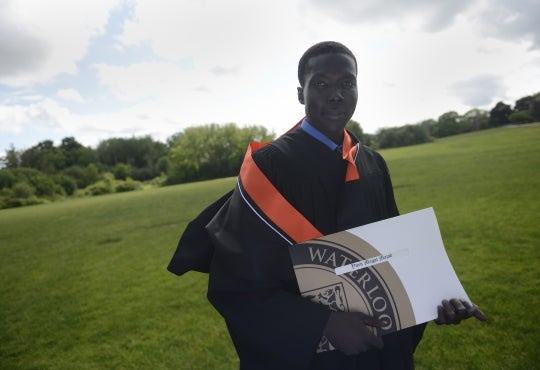Daniel Christian Tang (DCT) is a Toronto based, 3D-printed jewelry brand dubbed "wearable architecture,” that has received immediate attention for its unique appeal and beautiful designs.
DCT has recently launched their online store and offered their line on The Shopping Channel this summer, selling out of multiple pieces. The up and coming brand recently signed a contract with high-end fashion retailer, Holt Renfrew.
Alumni Relations had the chance to meet up with one of the three founders behind the quickly expanding brand, Luca Daniel (BASc ’12) to ask him about their innovative jewelry pieces and about life after Waterloo.
-----------------------------------------------------------------------------------
DCT uses 3D print technology to create intricate jewelry pieces that are said to “transcend the realm of traditional jewelry.” Can you tell us why you decided to use this approach to create these highly unique pieces?
Myself and my co-founders were all educated in either structural design or architecture and were extremely passionate about the application of 3 Dimensional CAD software to create parametric designs for fashion and furniture pieces. 3D printing became the only means to prototype and test these new designs in hand, which can be extremely complex and unique.
What type of 3D Printing technology does DCT use and can you tell us about the process?
It's an additive processes in which successive layers of material, in our case, wax, are laid down under computer control based on a 3D file that we design. We use the same CAD software that architects use in the design of a building. Once the print is complete it is individually lost wax cast. The process, however, is unique because DCT moulds are completely broken apart to remove the complex cast design. In this way, each piece is individual and unique; each piece starts from scratch with a new print and new cast every single time.
Can you tell us how your Bachelor of Applied Science in Structural Engineering has helped you create DCT and the unique pieces you offer?
Studying to become a structural engineer has trained me to understand limits of design processes and strive to optimize the use of structural materials to achieve desired aesthetics. 3-dimensional parametric designs made in a normally soft material like sterling silver can be unbelievably beautiful and complex, but at the same time extremely strong and light. The passion for designing and improving architecturally inspired pieces comes directly from my studies in structural engineering and my enthusiasm for materials science.
Was there something or someone at the University of Waterloo that influenced you into getting to where you are today?
It is very unlikely I would have started my own businesses if it weren’t for the co-op program at the University of Waterloo. My co-op positions were all very different and in varying industries that allowed me to grow a vast and varied skill-base from web design and e-commerce, to accounting and structural design. Learning the different corporate structures and team compositions were also very helpful in learning how to effectively work with and maintain a highly functional team.
Where do you come up with the inspiration for your pieces?
Our style of design for the pieces is always inspired by nature and really shows in all our work. Our lead designer actually studied Biochemistry prior to his Masters in Architecture and it's quite apparent in our treatment of form, lending inspiration from natural structures and patterns found at the visible and microscopic level. Our first collections, the Hive and the Grid, were inspired by the honeycomb and cell structures respectively.
DCT is rapidly expanding. What are you looking forward to next?
We couldn't be more humbled by the support we've received for the brand and are thrilled to be already in the manufacturing stages with a brand new collection for winter 2015. Stay tuned for our new collection called The Flow collection conceptualized by the fluidity and sensuousness of water.
What advice do you have for aspiring entrepreneurs?
Continuously try to build and fine-tune your skills, as a founder or budding entrepreneur it will be very important to have an understanding of all aspects and facets of your business as you grow, not just those you specialize in. As a founder, your workday never really ends which can be extremely overwhelming. Make sure that the business you choose to build has an aspect that you are passionate about and can see yourself doing everyday (including weekends).






